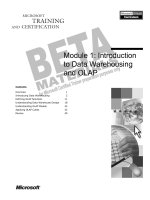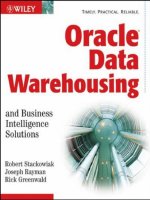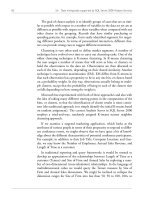wiley oracle data warehousing and business intelligence solutions jan 2007
Bạn đang xem bản rút gọn của tài liệu. Xem và tải ngay bản đầy đủ của tài liệu tại đây (12.01 MB, 409 trang )
Oracle
®
Data
Warehousing and
Business Intelligence
Solutions
01_919216 ffirs.qxp 11/21/06 10:28 PM Page i
01_919216 ffirs.qxp 11/21/06 10:28 PM Page ii
Robert Stackowiak
Joseph Rayman
Rick Greenwald
Oracle
®
Data
Warehousing and
Business Intelligence
Solutions
01_919216 ffirs.qxp 11/21/06 10:28 PM Page iii
Oracle
®
Data Warehousing and Business Intelligence Solutions
Published by
Wiley Publishing, Inc.
10475 Crosspoint Boulevard
Indianapolis, IN 46256
www.wiley.com
Copyright © 2007 by Wiley Publishing, Inc., Indianapolis, Indiana
Published simultaneously in Canada
ISBN-13: 978-0-471-91921-6
ISBN-10: 0-471-91921-7
Manufactured in the United States of America
10 9 8 7 6 5 4 3 2 1
1MA/RS/RS/QW/IN
No part of this publication may be reproduced, stored in a retrieval system or transmitted
in any form or by any means, electronic, mechanical, photocopying, recording, scanning or
otherwise, except as permitted under Sections 107 or 108 of the 1976 United States Copy-
right Act, without either the prior written permission of the Publisher, or authorization
through payment of the appropriate per-copy fee to the Copyright Clearance Center, 222
Rosewood Drive, Danvers, MA 01923, (978) 750-8400, fax (978) 646-8600. Requests to the
Publisher for permission should be addressed to the Legal Department, Wiley Publishing,
Inc., 10475 Crosspoint Blvd., Indianapolis, IN 46256, (317) 572-3447, fax (317) 572-4355, or
online at
/>Limit of Liability/Disclaimer of Warranty: The publisher and the author make no repre-
sentations or warranties with respect to the accuracy or completeness of the contents of this
work and specifically disclaim all warranties, including without limitation warranties of fit-
ness for a particular purpose. No warranty may be created or extended by sales or promo-
tional materials. The advice and strategies contained herein may not be suitable for every
situation. This work is sold with the understanding that the publisher is not engaged in ren-
dering legal, accounting, or other professional services. If professional assistance is
required, the services of a competent professional person should be sought. Neither the
publisher nor the author shall be liable for damages arising herefrom. The fact that an orga-
nization or Website is referred to in this work as a citation and/or a potential source of fur-
ther information does not mean that the author or the publisher endorses the information
the organization or Website may provide or recommendations it may make. Further, read-
ers should be aware that Internet Websites listed in this work may have changed or disap-
peared between when this work was written and when it is read.
For general information on our other products and services or to obtain technical support,
please contact our Customer Care Department within the U.S. at (800) 762-2974, outside the
U.S. at (317) 572-3993 or fax (317) 572-4002.
Library of Congress Cataloging-in-Publication Data: Available from publisher.
Trademarks: Wiley, the Wiley logo, and related trade dress are trademarks or registered
trademarks of John Wiley & Sons, Inc. and/or its affiliates, in the United States and other
countries, and may not be used without written permission. Oracle is a registered trademark
of Oracle Corporation. All other trademarks are the property of their respective owners.
Wiley Publishing, Inc., is not associated with any product or vendor mentioned in this book.
Wiley also publishes its books in a variety of electronic formats. Some content that appears
in print may not be available in electronic books.
01_919216 ffirs.qxp 11/21/06 10:28 PM Page iv
Robert Stackowiak is Vice President of Business Intelligence in Oracle’s
Technology Business Unit. He has worked for over 20 years in business
intelligence, data warehousing, and IT-related roles at Oracle, IBM, Harris
Corporation, and the U.S. Army Corps of Engineers. His papers regarding
business intelligence and computer and software technology have appeared
in publications such as President & CEO Magazine, Database Trends and
Applications, and The Data Warehousing Institute’s publications. He also
co-authored the books Oracle Essentials: Oracle Database 10g (currently in
3rd Edition, February 2004, O’Reilly), Oracle Application Server 10g Essentials
(1st Edition, August 2004, O’Reilly), and Professional Oracle Programming
(1st Edition, June 2005, WROX).
Joseph Rayman leads the Oracle Consulting Business Intelligence Practice
in North America with over 20 years of business experience in a vast array
of industries, including financial services, manufacturing, retail, telecom-
munications, healthcare, and federal government. His technical and busi-
ness leadership spans enterprise architecture design, enterprise data
modeling, VLDB system tuning, data warehouse design, data mining, and
quality assurance activities for data warehouse practices. Joe is a key con-
tributor in defining and authoring Oracle Consulting’s Data Warehousing
Methodology. Prior to joining Oracle, Joe designed and deployed business
intelligence and statistical analysis solutions for a large food manufacturer
and provided real-time trading and analysis solutions for a major interna-
tional financial organization.
About the Authors
v
01_919216 ffirs.qxp 11/21/06 10:28 PM Page v
Rick Greenwald has worked in the IT field for over 20 years for major ven-
dors, including Oracle, Gupta Technologies, Cognos, and Data General. He
has coauthored more than a dozen books, including Oracle Essentials: Oracle
Database 10g (currently in 3rd Edition, February 2004, O’Reilly), Oracle
Application Server 10g Essentials (1st Edition, August 2004, O’Reilly), and
Professional Oracle Programming (1st Edition, June 2005, WROX). Mr. Green-
wald currently works for Ingres Corporation.
vi About the Authors
01_919216 ffirs.qxp 11/21/06 10:28 PM Page vi
Executive Editor
Robert Elliott
Senior Development Editor
Tom Dinse
Production Editor
Angela Smith
Copy Editor
Michael Koch
Editorial Manager
Mary Beth Wakefield
Production Manager
Tim Tate
Vice President and Executive
Group Publisher
Richard Swadley
Vice President and Executive
Publisher
Joseph B. Wikert
Project Coordinator
Adrienne Martinez
Graphics and Production
Specialists
Carrie A. Foster
Stephanie D. Jumper
Barbara Moore
Heather Ryan
Alicia B. South
Quality Control Technicians
Jessica Kramer
Brian H. Walls
Book Proofreading
Techbooks
Indexing
Stephen Ingle
Anniversary Logo Design
Richard Pacifico
Credits
vii
01_919216 ffirs.qxp 11/21/06 10:28 PM Page vii
01_919216 ffirs.qxp 11/21/06 10:28 PM Page viii
Acknowledgments xv
Introduction xvii
Part I Oracle Business Intelligence Defined 1
Chapter 1 Oracle Business Intelligence 3
Business Intelligence and Transactional Applications 4
Daily Business Intelligence 5
Balanced Scorecard 6
Enterprise Planning and Budgeting 8
Activity-Based Management 9
Oracle Integration Components Enabling Business Intelligence 9
Data Hubs 10
Business Activity Monitoring 10
BPEL Process Manager 11
Enterprise Messaging Service 11
Custom Data Warehouse Solutions 12
The Role of the Oracle Database 14
Oracle Warehouse Builder 15
Oracle Business Intelligence Standard Edition 16
Oracle Business Intelligence Enterprise Edition 18
BI (XML) Publisher 20
Oracle Portal 20
Spreadsheet Add-ins 21
Building Custom Business Intelligence Applications 23
Emerging Trends 24
Contents
ix
02_919216 ftoc.qxp 11/21/06 10:28 PM Page ix
Chapter 2 Oracle’s Transactional Business Intelligence 27
Transactional Business Intelligence 28
Business Terminology 28
Oracle’s Daily Business Intelligence 30
How DBI Works 33
Varieties of DBI 34
Balanced Scorecards 45
Oracle Balanced Scorecard Structure 46
OBSC Architecture 48
Creating an Oracle Balanced Scorecard 48
Data Hubs 49
The Oracle Customer Data Hub 49
How Data Hubs Work 51
Other Oracle Data Hubs 51
Is Transactional Business Intelligence Enough? 52
Chapter 3 Introduction to Oracle Data Warehousing 53
Oracle Data Warehousing Basics 54
Oracle Database Analysis and Schema Considerations 55
Managing an Oracle-based Data Warehouse 64
Where to Start? 70
Oracle/PeopleSoft EPM 71
Oracle/Siebel Business Analytics Applications 73
Choosing Completely Custom 74
Chapter 4 Choosing a Platform 75
Scaling Up Platforms Versus Scaling Out 76
Hardware Platforms 77
Cost Considerations 80
Availability Considerations 80
Manageability Considerations 83
Sizing the Platform 84
Information Needed for Warehouse Hardware Sizing 85
Benchmarking 86
Sizing Hardware for Business Intelligence Tools 89
Your Strategy 90
Part II Custom-Built Data Warehousing Solutions 91
Chapter 5 Designing for Usability 93
Approaches for Design 94
Key Design Considerations 94
Features for Design — Enhancing Performance 98
Business Scenario 106
Normalized Design 108
Dimensional Design 110
Hybrid Design 113
x Contents
02_919216 ftoc.qxp 11/21/06 10:28 PM Page x
Online Analytical Processing Design 116
Other Considerations 120
Selecting the Best Approach 126
Chapter 6 Business Intelligence Tools 127
Oracle Portal and Portal Products 128
Using Oracle Portal 129
Building and Deploying Oracle Portal and Portlets 132
Reporting 136
BI/XML Publisher 137
Oracle Reports 140
Oracle BI Reporting Workbench (Actuate) 141
Ad hoc Query and Analysis 142
Business Intelligence Enterprise Edition 143
Discoverer and Business Intelligence Standard Edition 153
Oracle Spreadsheet Add-ins 162
Building Business Intelligence Applications 165
JDeveloper and BI Beans 166
Data Miner 166
Other Tools 169
Chapter 7 Data Loading 175
Oracle Database Data Loading Features 176
Embedded ETL in the Oracle Database 177
SQL*Loader 178
Change Data Capture 179
Transportable Tablespaces 180
Data Pump 180
Oracle Warehouse Builder 181
OWB Packaging 181
Typical Steps when using OWB 182
ETL Design in OWB 184
OWB and Dimensional Models 189
The OWB Process Editor 191
Balancing Data Loading Choices 192
Chapter 8 Managing the Oracle Data Warehouse 195
Oracle Enterprise Manager Grid Control 196
Database Performance Monitoring 200
Database Administration 202
Database Maintenance 218
Database Topology 223
Management and Management Options 224
Chapter 9 Data Warehouse Performance Tuning and Monitoring 227
Understanding Performance Challenges 228
Who Is Responsible? 228
Causes of Poor Performance 231
Contents xi
02_919216 ftoc.qxp 11/21/06 10:28 PM Page xi
Successful Approaches to Performance Tuning 238
Critical Tasks for Performance Tuning Lifecycle 239
Hardware Configuration 244
Software Configuration 247
Database Application Design 256
Business Scenario: Tuning Our Sample Solution 257
Where To Start 257
Enterprise Manager Advisory Framework 258
Approaches for Success 273
Part III Best Practices 275
Chapter 10 Scoping the Effort and an Approach for Success 277
Uncovering Key Business Initiatives 278
Where to Start 278
Information Sources 280
What is Important 282
Accountability and Securing Business Sponsorship 282
Establish a Steering Committee 283
Project Review Board 283
Endorsing a Methodology 284
Choices of Methodologies 284
A Business-focused Approach 285
Staffing the Project 293
Organization Structure 293
End-User Experience 299
Engaging the Business: Education and Training 301
Managing Risk 301
Communication — Managing Expectations 301
Contingency Allocation 302
Financial Risk 303
Technology Risk 304
No Place to Shortcut 305
Chapter 11 Understanding Business Needs 307
How Bad Deployment Choices Impact the Business 308
Independent Data Marts 308
Limited and Inflexible Reporting 310
Sources of Information Limited to Internal Data 311
Limited Data History 311
Lack of Current High-Quality Data 312
Limited Growth Flexibility 313
Project Drivers and Business Types 314
Financial Companies 314
Healthcare 316
Manufacturing 318
Media and Entertainment 319
xii Contents
02_919216 ftoc.qxp 11/21/06 10:28 PM Page xii
Retail 319
Telecommunications 320
Other Business Types: Transportation and Utilities 321
Educational Institutions 321
Government Agencies 323
Developing Scope and Gaining Business Support 326
Chapter 12 Justifying Projects and Claiming Success 329
Concept to Project 330
Business Constraints 330
Where to Start Justification 330
Measuring Value 331
Common Metrics to Measure 332
Common Budgeting Techniques 349
Total Cost of Ownership 356
Modeling Total Cost of Ownership 357
Return on Investment 360
Modeling Return on Investment 360
Claiming Success 363
Index 365
Contents xiii
02_919216 ftoc.qxp 11/21/06 10:28 PM Page xiii
02_919216 ftoc.qxp 11/21/06 10:28 PM Page xiv
We begin by acknowledging the support of our families, especially our
wives who realize that authors sometimes get a bit cranky and difficult as
deadlines approach. Although they probably hope there is not another book
coming from any one of us soon, we realize such an undertaking would not
be possible without the support of Jodie Stackowiak, Donna Rayman, and
LuAnn Greenwald.
Special thanks to the folks at Wiley Publishing who worked their magic
to turn the documents and screen-captured images from our laptops into
the book you have in front of you. We would especially like to thank Tom
Dinse, our Senior Development Editor, and Bob Elliott, Wiley’s Executive
Editor who understood the need for such a book.
Within Oracle, we have had the great fortune to work with many people
skilled in this area. From Oracle Development, we would like to acknowl-
edge the following who have provided us with guidance over the years
that was especially relevant for this book: George Lumpkin, Robert Ash,
Hermann Baer, Andrew Holdsworth, Paul Narth, Jean-Pierre Dijcks, Paul
Rodwick, Chris Leone, and Ray Roccaforte. We would also like to acknowl-
edge the contributions of business intelligence specialists in the Technology
Business Unit, especially Louis Nagode, Gayl Czaplicki, Derrick Cameron,
Jim Bienski, Alan Manewitz, Joan Maiorana, and the Enterprise Technol-
ogy Center under Jim Olsen where we were able to illustrate some of the
large-scale management capabilities.
Acknowledgments
xv
03_919216 flast.qxp 11/21/06 10:01 PM Page xv
Oracle also has a great many business intelligence specialists within sales,
consulting, and other organizations around the world who remind us of
the day-to-day challenges that their customers face when building these
solutions. Some of the key individuals who influenced the content in this
book include David Pryor, Susan Cook, Steve Illingworth, Nick Whitehead,
Jon Ainsworth, Kevin Lancaster, Craig Terry, Joe Thomas, Rob Reynolds,
Rich Solari, Nuge Ajouz, Ken McMullen, Brian MacDonald, and Patrick
Viau. There are many more, of course.
Lastly, much of the content in this book is based on the experience of the
authors. Some of the descriptions of what to avoid are based on observa-
tions we made of less successful techniques used by Oracle’s customers.
But many of Oracle’s customers and partners provide innovation and tech-
niques that take product features and turn them into useful solutions. We
have had the fortune of dealing with both types of customers, and this
book is much stronger and realistic because of what these customers and
the Oracle partners have shared with us. So, thank you to all of you whom
we have worked with over the years. We especially hope you find this
book to be of value as you build and develop your own solutions.
xvi Acknowledgments
03_919216 flast.qxp 11/21/06 10:01 PM Page xvi
We are now decades into deploying decision support systems, data ware-
houses, and business intelligence solutions. Today, there are many books
that describe data warehousing and design approaches. There are many
books that describe business intelligence. There are many books that
describe the Oracle database. So you may be asking, why did the authors
decide to write this book?
The fact is, the authors of this book still hear comments from many of
you that business intelligence and data warehousing projects are problem-
atic. This seems to be true regardless of database technologies or business
intelligence tools selected and deployed. While the wealth of Oracle skills
and resources that exist might make this less true where Oracle technology
is part of the solution, the number of implementations that face significant
issues and the repetition of mistakes convinced the authors that too few
projects are approached holistically. Not many of the books that are avail-
able as resources look at Oracle business intelligence and data warehous-
ing in such a manner.
This book attempts to give you a single reference that covers a diverse
range of relevant topics in providing a holistic approach. It covers the data-
base and platform technology, of course. But it also covers business intelli-
gence tools, emerging business intelligence applications, architecture choices,
schema selection, management and performance tuning, requirements
gathering, and justifying the project. Tips are included throughout the book
based on real experience and implementations.
Introduction
xvii
03_919216 flast.qxp 11/21/06 10:01 PM Page xvii
Your tendency might be to jump to sections you know something about
or suspect as being a possible solution to a problem in order to further
develop your knowledge of a specific topic. Although you should find
value in using this book that way, keep in mind that the reason many imple-
mentations struggle is due to ignoring areas that should be understood and
are outside the core competencies of those engaged in the project.
To sum it up, the goal of this book is more than about gaining academic
knowledge. If this book attains its objective, you will gain knowledge that
you can apply to your own project such that your deployed solution will be
viewed as successful technically within Information Technology (IT), but
also successful because it delivers the business value that your business
community recognizes.
Who This Book Is For
This book should appeal to a wide audience. Although those in IT will find
it particularly useful, more technically inclined business analysts and man-
agers should also find value in topics such as justifying projects and evalu-
ating deployment choices.
Within IT, the day-to-day management and modification of such an
infrastructure often falls on database administrators, programmers, and
systems managers. Certainly, we cover topics of interest to this group.
Unfortunately, the value of architects and project managers in deploying
and updating such solutions is often overlooked. There is plenty in this
book that should also appeal to that audience.
How This Book Is Organized
This book is divided into three parts:
Oracle Business Intelligence Defined
Custom Built Data Warehousing Solutions
Best Practices
Part I: Oracle Business Intelligence Defined
Part I provides a broad background as to possible Oracle-based solutions
and how you might deploy them. The database and business intelligence
tools are introduced here, but other related topics are covered as well in the
following four chapters.
xviii Introduction
03_919216 flast.qxp 11/21/06 10:01 PM Page xviii
Chapter 1: Oracle Business Intelligence
A broad introduction of Oracle business intelligence is provided. Topics
introduced include Oracle’s transactional business intelligence, integration
components, and components in custom-built data warehouses and busi-
ness intelligence solutions.
Chapter 2: Oracle’s Transactional Business Intelligence
Sometimes called operational business intelligence, this chapter describes
Oracle’s Daily Business Intelligence modules, Balanced Scorecard solution,
and Data Hubs (used in master data management). You are provided with
guidance as to where such solutions might be particularly useful and why
a data warehouse might also be deployed to augment such a solution.
Chapter 3: Introduction to Oracle Data Warehousing
The introduction of this topic covers the wide array of features in the Ora-
cle database that are relevant in data warehousing. More detailed explana-
tions are provided in Part II of this book. In addition, the chapter covers the
data models that Oracle provides for its applications as pre-built data
warehousing solutions.
Chapter 4: Choosing a Platform
The basics of choosing a hardware platform are covered including scaling
up versus scaling out and how to size your choice. Specifics addressed
under these broad topics include high availability considerations, manage-
ability considerations, and approaches to benchmarking.
Part II: Custom-Built Data Warehousing Solutions
Most business intelligence solutions today are custom built. Part II
describes design approaches and deploying and managing business intel-
ligence tools and an Oracle data warehousing database. These are
explained in the following five chapters.
Chapter 5: Designing for Usability
Covering approaches to design, topics in this chapter include how to leverage
Oracle features and an illustration of how these features can be used to pro-
vide solutions to needs driven by a business scenario. Schema approaches
are described including third normal form, star schema, hybrids, and
Online Analytical Processing (OLAP).
Introduction xix
03_919216 flast.qxp 11/21/06 10:01 PM Page xix
Chapter 6: Business Intelligence Tools
This chapter introduces using and deploying Oracle’s wide array of busi-
ness intelligence tools, including portals, reporting, and ad hoc query and
analysis tools. The Oracle Business Intelligence Suites (Standard Edition
and Enterprise Edition) are covered. In addition, the Oracle database sup-
port provided by business intelligence tools available from other vendors
is described.
Chapter 7: Data Loading
Embedded extraction, transformation, and loading (ETL) features provided
by the Oracle database are described in this chapter. Oracle Warehouse
Builder’s role in ETL, target data warehouse design, data quality analyses,
and metadata management is also described.
Chapter 8: Managing the Oracle Data Warehouse
Oracle Enterprise Manager provides a useful interface often used in man-
aging Oracle data warehouses as described in this chapter. The Grid Control
interface for managing clusters is illustrated, as are interfaces for basic per-
formance monitoring, administration, and maintenance.
Chapter 9: Data Warehouse Performance Tuning and Monitoring
Typical performance challenges are described and proven approaches to
solving such challenges are presented. We then illustrate using such
approaches to tune the data warehouse first described in the business sce-
nario presented in Chapter 5.
Part III: Best Practices
Understanding the technology is great, but is no guarantee of success. Part
III will help you identify potential risk and best approaches for mitigating
risk as you develop and deploy your solution. These best practices are
described in the following three chapters:
Chapter 10: Scoping the Effort and an Approach for Success
This chapter describes how to uncover initiatives by your business com-
munity, securing business sponsorship, endorsing a methodology, project
staffing, and managing risk.
xx Introduction
03_919216 flast.qxp 11/21/06 10:01 PM Page xx
Chapter 11: Understanding Business Needs
Business needs for better business intelligence might be driven by a poorly
designed solution or by a new business requirement. Examples of less opti-
mal solutions and how they can impact the business are first described in
this chapter. Typical project drivers driven by business requirements are then
presented followed by suggestions on how to build support for a project.
Chapter 12: Justifying Projects and Claiming Success
Getting the go-ahead to build a solution often requires financial justifica-
tion. This chapter identifies the potential costs you should consider and
where business benefits might come from. Financial benefits are computed
for a variety of scenarios and computing return on investment (ROI) is
described.
Illustrations in the Text
Oracle product illustrations in the text are captured from recent Oracle
software versions. You should be able to leverage similar capabilities
regardless of your Oracle software version provided you have Oracle Data-
base 10g, Oracle Business Intelligence 10g, or newer releases of these prod-
ucts. We frequently indicate when key features were introduced in these
products so that if you have older releases deployed, you can understand
limitations you might face.
From Here
To become an expert on this topic usually requires years of practice and
learning, implementations for a variety of companies and organizations,
and the uncommon ability to feel equally at home discussing needs and
details among both IT and business co-workers. For those that grow in
such expertise, there is great opportunity and potential reward.
This book is intended to help lay that foundation. Of course, your suc-
cess will depend not only on what you read in the following chapters, but
also on how you put what you learn here into practice in the solutions you
work on. As you now start reading this book, it is our hope that it will help
you avoid many common pitfalls and that you will gain a better perspec-
tive on how to attain professional success in building and deploying such
projects.
Introduction xxi
03_919216 flast.qxp 11/21/06 10:01 PM Page xxi
03_919216 flast.qxp 11/21/06 10:01 PM Page xxii
PART
I
Oracle Business
Intelligence Defined
In This Part
Chapter 1: Oracle Business Intelligence
Chapter 2: Oracle’s Transactional Business Intelligence
Chapter 3: Introduction to Oracle Data Warehousing
Chapter 4: Choosing a Platform
04_919216 pt01.qxp 11/21/06 10:02 PM Page 1
04_919216 pt01.qxp 11/21/06 10:02 PM Page 2









